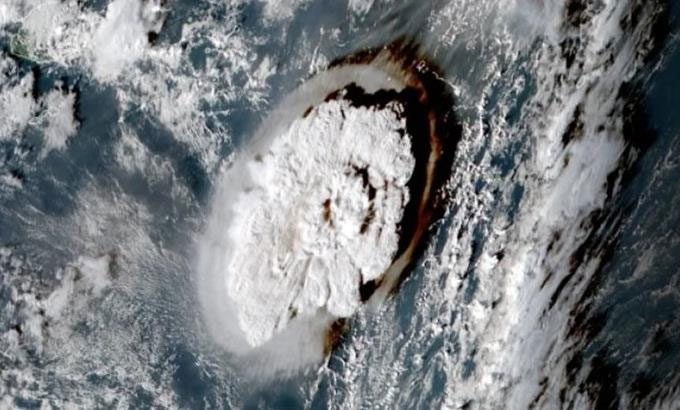Scientists have discovered an incredible mechanism that caused 15-meter-high tsunamis to spread across three oceans in just 20 hours, even mysteriously crossing South America: a terrifying type of acoustic wave.
Sound that Causes Tsunamis, a concept that seems like science fiction, became a reality during the tsunami triggered by the Hunga Tonga – Hunga Ha’apai eruption at the beginning of 2022, impacting several countries in Oceania, Asia, North America, and South America.

Satellite image of the famous Hunga Tonga – Hunga Ha’apai eruption in early 2022 – (Photo: JAXA/JMA).
According to Science Alert, waves reaching heights of up to 15 meters at certain locations broke records for what shock waves from a volcano can cause.
This phenomenon is known as “acoustic gravity waves” (AGW), according to geologist Ricardo Ramalho from Cardiff University in the UK. AGW is a special type of long acoustic wave that can rapidly propagate through the ocean, rise into the atmosphere, and extend beyond the waves generated by volcanic eruptions. When many such “monster roars” converge, they add energy to the tsunami.
This means that the tsunami is larger, lasts longer, travels farther, and moves faster than usual. “The idea that tsunamis can be created by atmospheric waves caused by volcanic eruptions is not new, but this event was recorded for the first time by modern, dense measuring devices around the world,” Dr. Ramalho stated.
A combination of data recorded from sea levels, the atmosphere, and satellite data was used to identify the presence of these waves, showing a direct correlation between the first signs of atmospheric disturbances caused by AGW and the onset of tsunamis at various locations.
The Hunga Tonga – Hunga Ha’apai eruption was a massive eruption, but underwater eruptions typically do not generate tsunamis of this scale, prompting scientists to investigate anomalies.
One type of “monster roar” can extend hundreds of kilometers or miles, and they can travel thousands of meters underwater at speeds close to the speed of sound.
The aforementioned tsunami moved 1.5 to 2.5 times faster than a typical volcano-triggered tsunami, reaching speeds of about 1,000 km/h as it crossed the Pacific, Atlantic, and Indian Oceans in less than 20 hours.
Furthermore, because it moved partly through the atmosphere, the tsunami was able to reach the Caribbean and the Atlantic without having to go around South America.
This research has just been published in the journal Nature.





















































